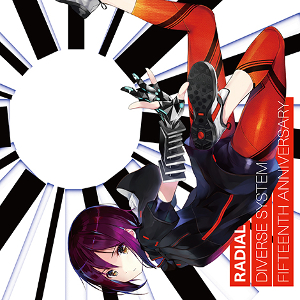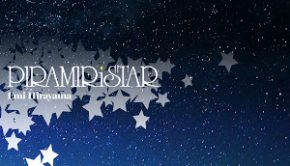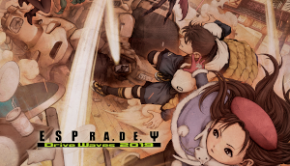RADIAL
 |
Album Title: RADIAL |
| Record Label: Diverse System |
|
| Catalog No.: DVSP-0150/4 |
|
| Release Date: August 24, 2016 |
|
| Purchase: Buy at Diverse Direct |
Overview
Diverse System is a record label that publishes original albums during the Comic Market and M3 events held twice a year in Japan. The albums themselves are primarily electronic in nature and feature a range of musical styles. Some of the albums focus on a particular style, such as trance, or on a particular instrument, such as piano, and typically feature both commissioned pieces from game composers and independent artists, as well as pieces that were submitted by artists when an open audition for a particular album was publicized on the Diverse System website. Released during Comic Market 90, RADIAL features music spanning over 5 CDs, each a commissioned piece, premiering for one week on Youtube to commemorate the milestone of the 15th anniversary of Diverse System. This CD compiles all of the pieces that debuted from Comic Market 88 until just before the most recent C90 event. Featuring a variety of styles, both in the electronic realm as well as other genres, how does this original album measure up?
Body
The album opens with sakyuzo’s “First Dance,” which features of blend of Japanese instruments, catchy rhythms and melody, glitchy drum n’ bass, and operatic vocals, to create a high energy dance tune that starts off the album with a bang. Following that is “Genesis,” by Blacklolita, a dubstep tune that features a nice melody but comes off a bit generic. Tosh’s “The Red Eve” is a trance tune with a great progression, featuring ethereal synths, an excellent melody, and some calmer sections that build a lot of musical texture. Another trance tune is “Back to You,” co-composed by Takahiro Eguchi, of Supersweep, and Tomohiko Togashi, both of whom collaborate quite frequently for Diverse System releases. The tune itself features some great beats, has an ethereal quality to it, and has a beautiful piano section with an equally beautiful melody that gets layered into the tune in its progression quite skillfully. A glitch hop tune by MAYA AKAI and MC TNKT called “Burping” follows and is a bright tune and fun with its catchy beats, piano chords, hip hop influence, mainly in the vocal samples, and the synth melodic sections.
There are three uplifting trance tunes featured on the first disc. The first, “Falling Universe,” by RIC, features spacey synths, a catchy melody, excellent progression, and a beautiful and calming breakdown section. “Moonrise,” by void, is similar to the above mentioned description, but I particularly enjoy the piano focus and the great interplay between it and the electronic elements of the piece. Lastly, “Moonset,” by Junk, mirrors “Moonrise” in its approach, but is certainly more synth focused and has a more crystalline feel to it. RIN’s “Go Way,” an electro tune follows and is a nice club tune with airy synths, catchy beats, and has a lounge vibe going for it. The vocal samples lend itself well to the style of the music and the overall progression of the piece is quite good. The final track on the first disc is “You Are Gone” by ETIA. It’s done in a UK Hardcore style and has a typical hardcore sound. It’s predictable in its progression, but features a nice melody with the vocal samples and piano do complementing the music, nonetheless.
The second disc opens with “Lunarfall” by Tsukishiro Hikari pres. Reimu. It’s a progressive house piece that has a hypnotizing and atmospheric quality to it thanks to its ethereal accompaniment, piano, and beautiful melody. qurter’s “euclase,” which follows, is an electronica tune that features a great blend of higher pitched synths and low industrial sounding accompaniment that complement the melodic manipulation quite wonderfully. Much like the first disc, there are four tunes on the second disc that focus on a specific style of music, in this case, trance. “Pegasus,” by Ym1024, features a nice progression but is a bit basic in terms of execution. The middle section that lacks any beat features a lovely melody and a softer sound that complements the overall tune. “Cloudfleer,” by Taishi, is an interesting interpretation of trance, featuring an industrial flavor with distorted and glitchy effects. When present, the melody also features a bit of an industrial sound and serves the overall piece quite nicely. Alinut’s “Chronosphere” has a fun, summery beat and an airy quality to it and a decent melody, but isn’t the best representation of the genre on the album. Lastly, “SKYCRUISER,” by 2X , features a traditional trance beat but focuses a lot on piano and piano runs, in particular, that help lift up the excellent melody and great progression of the tune.
satella’s “Lucent Planet,” is a progressive trance tune that opens up quite mysteriously before moving onto heavy beats and otherworldly accompaniment with a great synthesized melody. It’s a tune that is a lot of fun to listen to and certainly is one of the highlights on the second disc. “Seasons,” by Ryunosuke Kudo, falls under the Future genre of electronic music. Featuring R&B flavors, soulful vocal samples, and a nice synth focus and progression, it’s a tune that also manages to stand out while also featuring a fantastic melody. “Nymphai,” by MYTK, is a progressive psytrance tune that really adds a nice refreshing take on the psytrance genre. It’s ethereal and features some excellent melodic manipulation that complements the accompaniment quite nicely. Lastly, Atomic’s “Artificial Mind” is a techno piece that is quite industrial in nature. It does, however, rely a bit too heavily to the point of being oversampled on coarse male voices. The end result is one that is a bit on the dramatic side. On a positive note, the beautiful softer synth melody contrasts quite nicely with the harsher atmospheric tones.
The third disc opens up with “16777215,” composed and sung by b. The minimalist electronic approach coupled with its excellent melody and performance, in some ways, reminds me of Imogen Heap’s style and gives the tune an ethereal quality to it. The chorus of the tune is particularly catchy. It’s certainly a highlight of the entire release. “Capella,” by sweez/Meine Meinung, is an ambient tune featuring soft melodies and accompaniment, in a range of instruments (guitar, piano, and vocals). The tune itself is beautiful and non-intrusive and adds another example of softness to an album that is predominantly more energy oriented. tigerlily’s “Parabola,” considered a post rock tune, is a piano focused piece featuring plenty of drumpad and guitars. It suffers from its extremely repetitive nature, especially towards the beginning, making for a slow start. As the piece progresses and gets going, it features some jazzy tones, but at that point, it’s not nearly as effective. “Guilty Motions,” by good-cool, is a guitar instrumental that features an excellent melody that is quite catchy and some skillful guitar playing. The overall piece is very reminiscent of something you might hear on a Gitadora game or on a ViViX release, stylistically speaking.
Much like the first two discs, the majority of the disc is dominated by a single style, in this case, house. “Casio Triangle,” by naotyu-, is a tune with a saxophone led melody over catchy beats with a jazz undertone. This is reinforced by the jazzy piano solo. The overall feel is one of a lounge vibe. Another lounge vibe is present in “Focus” by Kenichi Chiba. There is a bit of a tech house influence and a bubbly melody, but falls a bit with its repetitive nature. “Now and Then feat. crow,” by 100-200+tanigon, certainly brings with it a 90s influence. It’s a great dance tune that incorporates some jazz elements, mainly due to the saxophone, while the vocals give the overall piece a soulful vibe. Yamajet’s “Synthesized Dancefloor” has a bit of a game-y sound meets disco house. The end result is a fun melody and a real joy to listen to. The highlight of the house tunes on the disc is certainly “Glacier” by Powerless. It features a beautiful combination of electronic and piano elements. The dramatic opening is a striking contrast to the more upbeat and catchy beats featured later in the piece. The melody itself is quite strong and is supported by piano, guitar, and orchestral components. Another loungey tune is Scud2’s “We Saw the Same Sunset”, with its ambient accompaniment and chill melody at atmosphere. While it certainly works for what it is trying to accomplish, it isn’t the most engaging piece either.
The disc ends with ongaq’s Masaki Kawasaki’s “Hazakura,” which roughly translates to “cherry tree whose blossoms have fallen, revealing the young leaves.” The tune itself is orchestral in nature, featuring a bright and joyous sound, harboring the feeling of new beginnings and spring. The bell tones and piano conjure up images of spring, as do the bird chirping incorporated into the piece. The melody itself is wonderful and uplifting, making for a lovely close to the disc.
xi’s “White Peak,” which opens up the album, is classified as hard art core and has a very beatmania sound to it. The frenetic synths and piano focus of the piece help to create and support its beautiful and the overall progression certainly keeps you on your toes. Earbreaker’s “Where Are You Going?,” also features a beautiful melody, primarily synth based, in the opening, before leading into a club beat with a bubbly melody with some vocal samples. The overall piece is one that is enjoyable and quite fun to listen to. Masayoshi Minoshima’s “Invisible Hand,” is a progressive house tune that blends industrial tones with a chill vibe. It’s an atmospheric and relaxing tune, but one that is also fairly predictable. One of the highlights on the disc, and album, in my opinion, is “Heure bleue” by RANDO:. Done in a chillhop style, it’s a piece full of crystalline synth, bubbly FM synth, otherworldly synth, and an exquisite piano melody. Another unique tune on the album is Keisuke Hattori’s “Mr. Science,” with its funky, progressive sound that implements jazzy tones. It might not be for everyone, but it certainly isn’t cookie cutter either. “Astra walkthrough,” by paraoka, is another tune with a very game-like sound. Opening with sharp electronic hits and piano, it moves into an industrial-sounding tune that sounds eerily similar to “Ridley’s Theme” from the Metroid series, before continuing onto energetic and bright synths that give off a shmup vibe. Overall, the tune is a bit chaotic and all over the place, but it does have its moments of clarity as well.
Of course, chaos breeds chaos and no other tune exemplifies this more than DJ TECHNORCH’s “Digital Kecak No. 5.” Its frenetic electronic synths, vocal samples, including gabber style, portions that seem to have an ondo influence in the accompaniment, and its ending that features exotic soundscapes reminiscent of traditional Indian music make for a very disjointed piece and one that is quite harsh. Things steer a bit back on course with “RUNNING” by cranky. Its future house style blends saxophone and heavily processed vocals with a decent melody and catchy accompaniment. However, the saxophone, at times, sounds a bit noodly and muzak-like for my tastes. Post progressive pop tune, “Hall of Mirrors,” by sta, certainly has that pop feel but the vocals leave a bit to be desired, which is unfortunate considering the melody itself is quite beautiful and catchy. The piano and distorted synths in the accompaniment are also a nice touch to the overall piece. sasakure.UK’s “Mother Goose Laboratory,” features a bubbly and playful melody with its piano and synth heavy piece. The overall sound is a bit disjointed but the soundscape presented is quite nice. Lastly, “Mai chiru hai no,” by Hiroyuki Oshima featuring Chie Fukami on vocals, ends the disc on a positive note with its electronica approach. The music itself is quite beautiful, characterized by its chill and ethereal atmosphere with strings and piano serving to reinforce the excellent melody.
“Northern Meteor,” by Fenlile a.k.a Xacla, is a trance tune with an atmospheric opening before slowly building into a more expected trance sound. The overall piece has an otherworldly feel to it characterized by its beautiful piano melody, starting off the disc on a positive note. Uplifting trance returns with Maozon’s “The Path of Us.” It has a typical progression for the genre and does sound a bit on the basic side, but the overall airy quality to the tune and the synth melody are things that do lift it up a bit, no pun intended. Nhato’s “Remind the Souls,” done in a progressive trance style, is the first major highlight of the final disc. Incorporating his melody from his AD:Trance 3 tune, “Forbidden Souls,” he ties his tune directly with a past work while also featuring heavy bits, distortion, an excellent melody and progression to create an incredibly powerful dance tune. Another highlight is kors k’s “Palace,” a high energy electronic piece that includes a variety of electronic styles, with dubstep and psytrance influences in particular, while also incorporating vocal samples and distorted sound effects. While it might sound chaotic, it is certainly a much more cohesive and enjoyable piece than other more chaotic pieces featured on the album. I was quite surprised by Ryu☆’s contribution, “Mind Meaning,” with its electrotech sound. As I’m not the biggest fan of his typical style heard in rhythm games, I was pleasantly surprised to hear a more subdued piece from him. Blending chiptunes with a tech house and electro beat, the end result is one with an excellent melody and is extremely fun to listen to. Universal J-Core tune, “ALTAiR,” by REDALICE, features a typical sound for the genre, with frenetic tempo and ethereal synths. The melody itself is fun and the overall tune heavy at times. It certainly doesn’t break any new ground though.
t+pazolite’s “Bon Bon Festa,” is done in a hardcore rave style, reminiscent of many hardcore techno tunes done by other game composers, such as SamplingMasters AYA, with vocal samples abound, some pentatonic scales particularly in the melody. The end result is fairly enjoyable for what it tries to accomplish. The real highlights of the final disc start with ongaq’s onoken. His “F-mine” tune is a beautiful blend of light electronica and drum n’ bass elements with piano and strings that help create a stunning melody and an otherworldly feel on the whole. The trend continues with Osamu Kubota, known for his work on Granado Espada, and his tune, “A Reading Man ~ Yomu Otoko.” It’s jazz style makes for sultry listening experience while at the same time providing a bit of a classical influence to the piano melody as well. It’s a blending of two worlds and is done so wonderfully. Not only that, there is a softer synth breakdown section that brings with it a bit of a reflective, almost angelic, feel to it. It is, in my opinion, the highlight of the disc. ongaq’s TaQ, who composed the titular theme, “RADIAL,” certainly showcases his strengths as a more cinematic composer. The combination of orchestral and electronic elements makes for a filmic touch with its subtle progression and ambient beauty. Of particular note is how the piano pierces through the ambience to had some musical texture to the piece. The end result is absolutely stunning. The final piece on the album, “RADIAL :|| Endroll,” uses TaQ’s composition and expounds upon it. Feryquitous, the artist behind the final tune, adds a more piano and percussive intensive element to the piece to create a more rhythmically engaging tune. While I do prefer the original, I feel that the additional elements complement the original quite well.
Summary
The 15th annivesary of Diverse System certainly called for something special. The end result, RADIAL, an album featuring 53 commissioned pieces, certainly isn’t without its lows, but is overwhelming positive in its outcome. While some pieces come off as a bit typical sounding for the particular genre, there is plenty of pieces that incorporate unique elements to said genres or are, at the very least, well produced. Fans of electronic music will certainly find something to enjoy here and those on the fence and looking to jump in can certainly look back at other Diverse System releases to get a general idea of how the album sounds on the whole.
Do you agree with the review and score? Let us know in the comments below!
4.5
Posted on October 21, 2016 by Don Kotowski. Last modified on October 23, 2016.














